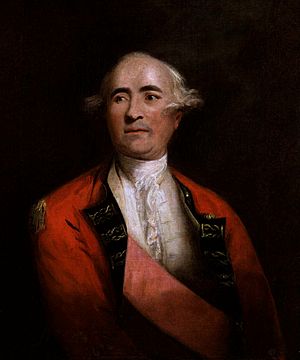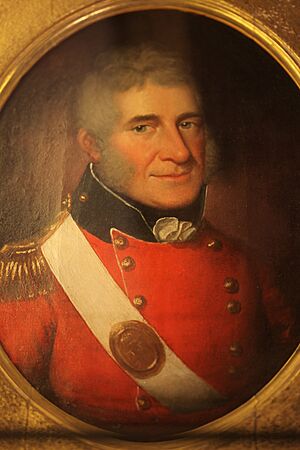Frederick Haldimand facts for kids
Quick facts for kids
Sir
Frederick Haldimand
|
|
|---|---|

Portrait by Joshua Reynolds, c. 1778
|
|
| Governor of Quebec | |
| In office 1778–1786 |
|
| Monarch | George III |
| Preceded by | Guy Carleton |
| Succeeded by | Guy Carleton |
| Personal details | |
| Born |
François Louis Frédéric Haldimand
11 August 1718 Yverdon, Switzerland |
| Died | 5 June 1791 (aged 72) Yverdon, Switzerland |
| Signature | |
| Military service | |
| Allegiance | |
| Years of service | 1740–1786 |
| Rank | Lieutenant general (British Army) |
| Commands | Military governor of Trois-Rivières, Quebec Military command of East and West Florida acting Commander-in-Chief, North America Colonel commandant, Royal American Regiment |
| Battles/wars | War of the Austrian Succession American Revolutionary War |
Sir Frederick Haldimand (born François Louis Frédéric Haldimand; 11 August 1718 – 5 June 1791) was a military officer from Switzerland. He is famous for serving in the British Army in North America. He fought during the Seven Years' War and the American Revolutionary War.
From 1778 to 1786, he was the Governor of the Province of Quebec. During this time, he led military actions against the northern parts of the American colonies. He also tried to make the independent Vermont Republic a new British province, but this plan didn't work out. His time as Governor was sometimes strict, and he arrested some people who spoke out against the government.
Contents
Early Life and Military Career
Frederick Haldimand was born in Yverdon, Switzerland, on August 11, 1718. He was one of four sons. His father was a public official. Frederick didn't get much formal schooling, but he became interested in the military when he was young.
In 1740, Haldimand became a mercenary, which means he was a soldier who fought for money for another country. He joined the army of Prussia. He fought in the War of the Austrian Succession, including the Battle of Mollwitz.
Later, in 1748, he joined the Swiss Guards of the Dutch Republic. He became a lieutenant colonel in 1750. There, he became friends with Henry Bouquet, another Swiss soldier. They would later serve together in the British Army.
Serving in the French and Indian War
In 1755, the Seven Years' War began. In North America, this war was called the French and Indian War. Haldimand and Bouquet joined a British army group called the Royal American. This group was made up of German and Swiss soldiers.
It took two years to form this group. There were some disagreements because of cultural differences with the rest of the British Army. However, Haldimand and Bouquet were very professional. This earned them the respect of the British military leaders.
Haldimand's group went to Louisbourg in 1758. Haldimand himself served under General James Abercrombie. He was at the difficult Battle of Carillon, where he got minor injuries.
After that winter, he was in charge of the British position at Fort Edward. In 1759, he became second-in-command for an expedition against Fort Niagara. He was also in charge of the important supply point at Oswego, New York, where he helped build Fort Ontario.
When the leader of the Fort Niagara operation, John Prideaux, was killed, Haldimand was supposed to take over. But William Johnson, an agent who worked with Native Americans, took command instead. Haldimand then returned to Oswego.
In 1760, he joined General Jeffery Amherst's army. They moved down the Saint Lawrence River. Haldimand was the officer who officially took control of Montreal on September 8 after the French gave up. He worked with the French leaders as they prepared to leave for France.
In 1762, Amherst made him a colonel. He temporarily made him the military governor of Trois-Rivières. This happened while its governor was away. At Trois-Rivières, Haldimand helped develop ironworks nearby.
Before the American Revolution
In 1764, the province of Quebec started to be run by a civilian government. Haldimand's job became smaller; he was just a troop commander. He wanted to go back to Europe, but he couldn't get permission. He stayed in Quebec until 1765.
After his friend Bouquet died, Haldimand was promoted to brigadier general. He was put in charge of military matters in East and West Florida. He stayed in this job until 1773. He found this role very difficult. He had problems getting supplies and money. The high cost of living there also put him in debt.
He was promoted again in 1772. He became a colonel commandant and then a major general.
American Revolution and War
General Thomas Gage called Haldimand to New York in 1773. He was asked to temporarily be the main commander of British forces in North America. This was while Gage was on leave in England.
During Haldimand's time in command, the political situation in the colonies got worse. He was careful not to let his troops get into fights with the local people. He refused to get involved in land disputes. He also wouldn't protect tea shipments after the Boston Tea Party unless he was specifically asked.
When Gage returned to Boston in 1774, Haldimand stayed in command of troops in New York. Gage later ordered these troops to Boston. This happened after a colonial uprising called the Powder Alarm. Gage was busy as Governor of Massachusetts. Haldimand commanded the army in Boston, but Gage didn't tell him about the expedition that led to the Battles of Lexington and Concord in April 1775.
More military leaders arrived in Boston after that event. Haldimand was told that because he was from another country, he shouldn't lead in what was seen as a problem within the British Empire. He left Boston in June 1775, just before the Battle of Bunker Hill. He arrived in London in August.
Governor of Quebec Province
Haldimand became Governor of the Province of Quebec in 1778. At that time, Quebec included what is now Ontario. He served during the entire American Revolution.
Haldimand strengthened Quebec's defenses. This was because there were many rumors that the Americans planned to invade the province again. He limited offensive actions to small raiding parties. These included the 1778 raid by Christopher Carleton and the 1780 "Burning of the Valleys" into the American colonies.
As a leader, he was sometimes tough on political activists. He arrested Fleury Mesplet and Valentin Jautard, who published a journal with political comments. He also arrested Pierre du Calvet, who wanted changes to the justice system.
In 1781, Haldimand tried to help the British cause. He talked with leaders from the Vermont Republic. Vermont had declared itself independent from New York in 1777. These talks are sometimes called the Haldimand Affair.
Haldimand talked with brothers Ira and Ethan Allen. He hoped Vermont could become a new British province. This would create a new way to attack New York and New England. The talks were going well, and Haldimand thought Vermont was almost ready to let British troops in. But then news arrived about the surrender at Yorktown, which ended the war.
As the revolution ended with the Treaty of Paris (1783), Haldimand helped American Loyalist refugees. Loyalists were people who supported the British during the war. Many of them settled in areas that are now New Brunswick and Ontario.
He and Sir John Johnson, who worked with Native Americans, also helped the Iroquois people. The Iroquois had been forced out of New York during the war. Haldimand issued the Haldimand Proclamation. This gave them land on the Grand River in what is now Ontario. This area is known today as the Six Nations reserve.
Later Life and Legacy
In the summer of 1784, Frederick Haldimand went back to England. He was on leave, but he never returned to Quebec. General Carleton officially replaced him in 1786. In 1785, he received the Order of the Bath, a special honor.
He lived in London, but he often visited his hometown of Yverdon. He died there on June 5, 1791, during one of his visits. Haldimand never married. He left all his property to his nephew.
Haldimand kept many written letters and documents. These writings are especially important from his time in North America. They cover the years 1755 to 1784. This collection of letters, known as the Haldimand Collection, is at the British Museum. Copies are also at Library and Archives Canada. It gives us a special look into the history of the colonies leading up to the United States becoming independent.
Several places in North America are named after Haldimand:
- In Canada:
- Haldimand County, Ontario
- Fort Haldimand at the Royal Military College of Canada in Kingston, Ontario. This fort was named after him in 1949.
- Haldimand River in Prince Edward Island
- Haldimand Beach (Plage Haldimand in French), Cape Haldimand (Cap Haldimand), and the areas of Haldimand East and Haldimand West, all near Gaspé, Quebec.
- Haldimand Cliff (Falaise Haldimand) on Brion Island in Quebec.
- In the United States:
- Haldimand Bay is the main harbor where boats land at Mackinac Island, Michigan.
Images for kids
-
Portrait of Haldimand at Castillo de San Marcos



